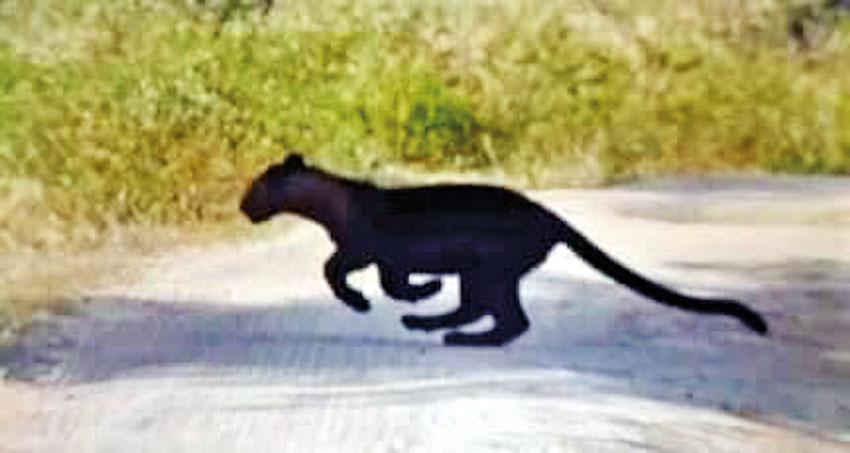
The leopard that has been spotted is a 5-6 month old male cub and from a wildlife point of view it is a rare species. Once the photos went viral on social media there has been a 90% increase in the number of visitors who are arriving at the park since Monday to catch a glimpse of the leopard
A photo and a video of a melanistic black leopard cub spotted at the Yala National Park is being shared widely on social media since last Friday(March 24). According to records, a black leopard has been spotted in Yala after about 50 years. “There have been records of a black leopard some 50 years ago, but the most recent sighting of a black leopard is the one that was recorded a few days ago,” said Yala National Park Warden Manoj Widyaratne.
“The leopard that has been spotted is a 5-6 month old male cub and from a wildlife point of view it is a rare species. Once the photos went viral on social media there has been a 90% increase in the number of visitors who are arriving at the park since Monday to catch a glimpse of the leopard. The number of vehicles in the area that the leopard has been spotted has now increased causing a heavy traffic and this may put the leopard and its mother under stress. The vehicles are so much that the two animals are even finding it a challenge to cross the road. With such an unnecessary burden the mother might even have a tendency to change the territory and take the cub elsewhere. The next location might be closer to a bordering village and in that case they are at risk of falling prey to traps including snares. If this visitor behavior continues we may have to close down the area to ensure the safety of the animals,” Widyaratne cautioned.
When asked what sort of awareness is being done to ensure that the leopard and its family is being protected, Widyaratne said that they have already informed wildlife guides, Jeep drivers and trackers to refrain from giving unnecessary attention to the black leopard cub. “Some have even gone to the extent of bypassing park rules and continuing their safari rides beyond 6.00pm just to ensure that the visitors catch a glimpse of the species. Such acts will not be entertained,” Widyaratne underscored.
“Melanism occurs due to an animal having recessive or dominant alleles,” explained Sethil Muhandiram, conservationist/carnivore researcher at Leopocon, an organization exclusively dedicated to conserve the Sri Lankan leopard and its ecosystems. “Alleles are essentially variations of normal genes. In leopards, the pigment is caused by a recessive allele. In jaguars, it is caused by a dominant allele. It is believed that only 5-10% of total population become panthers and over the past couple of decades around 3-4 panther deaths were reported within the island and the sighting of panthers date back to 1821. In many cases there were confirmed reports within the dry zone landscape of the country and panthers were no strangers to the Sri Lankan wilderness.”
“But unfortunately with their color, society has given them a higher value which have made them vulnerable. The deaths that occurred in recent past indicate that some of the deaths were intentional and the snares which cause these deaths were intentionally targeted at the animal. We have reports of panthers and their presence throughout the country and local authorities and other environmental organizations are very discreet towards their presence,” he added.
Speaking about the recent incident at Yala National Park, Muhandiram said that conservation disciplines have never been more challenged than today because of technology. “Conventionally, conservationists have argued that sharing the locations of vulnerable species gives poachers a leg up on the animals, making those on-the-brink species even more vulnerable. It is undeniable that in some cases, poachers have used published data to hunt down rare animals for the illegal wildlife trade. Yet sometimes the attention may help protect wildlife as well,” he said while adding that it is our responsibility to protect, not pursue for fame.
Issuing a statement, the Wildlife and Nature Protection Society urged the public to act responsibly at this critical juncture. “The sighting of an incredibly rare melanistic leopard has once again created a lot of hype, especially among wildlife photographers in Sri Lanka.
The WNPS urges all photographers and the public to act responsibly at this critical juncture, without overrunning the park to get the perfect photograph. We also encourage those who have already witnessed this sighting to avoid publishing its whereabouts on social media to minimise its exposure. It’s at times like this that we must protect, not pursue. All species possess the right to roam their territory undisturbed, and if we run this vulnerable species to the ground, we may never catch a glimpse of it again,” the statement read.









